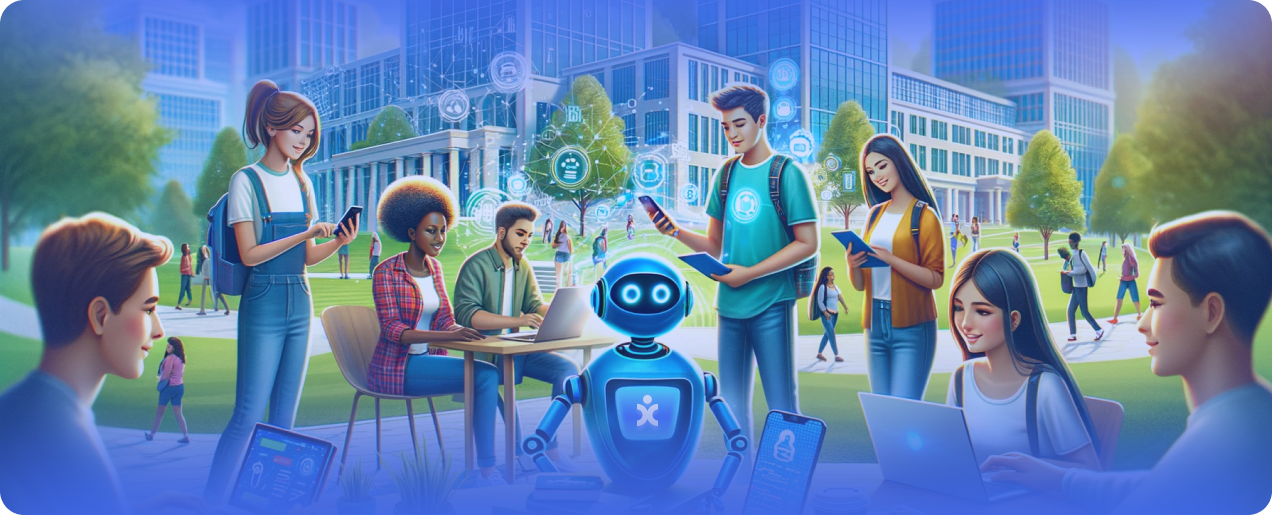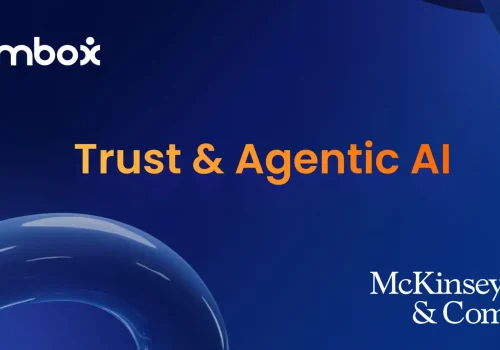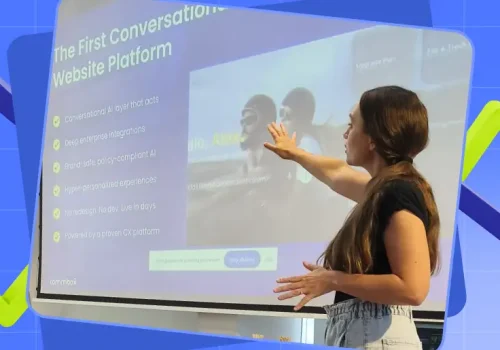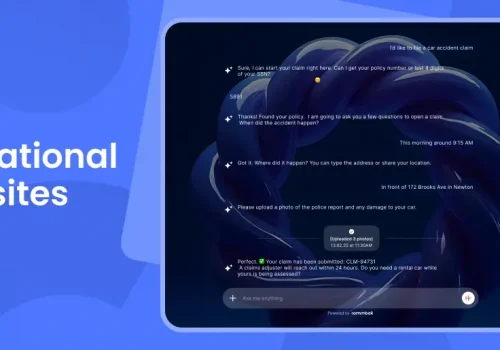Introduction – Meet Your New Campus Connector: How AI Chatbots Are Bridging the Gen-Z Gap in Universities
Welcome to the new digital frontier of higher education, where generative AI chatbots for student support transform how universities communicate. Bygones are the days when the only things bridging the generational gap were shared dining halls and the occasional campus event.
Today, these intelligent systems are not just another technological advancement; they represent a fundamental shift in how universities engage with their students. AI is the ultimate go-between, unifying cross-channel communications and connecting Gen-Z students with their academic institutions. This post dives into the witty, wise, and web-savvy world of how AI chatbots are transforming the way educational institutions provide support, offering a seamless, personalised, and always available service that meets the needs of today’s digital-native students.
Why AI Chatbots Are Crucial?
What is the buzz around AI chatbots? Digital communication has become integral to students’ daily lives, making traditional engagement methods increasingly obsolete—think Instagram DMs, Tweets, and TikTok comments. Emails often go unread, and important announcements can get lost in many digital interactions. Enter AI chatbots as the new campus heroes who speak the language of the students they serve, offering a solution that speaks the language of the digital generation and providing instant and relevant responses across multiple platforms.
AI Chatbots for Student Support
AI chatbots aren’t your typical campus administrators. They are sophisticated software applications that simulate human conversation through voice commands, text chats, or both. Developed to be quick on the draw, AI chatbots provide instantaneous responses to student inquiries across various digital channels. They use natural language processing (NLP) to understand and respond to user queries in real-time, providing an interactive and engaging experience.
These chatbots can handle various student inquiries, from administrative questions to personalised academic advice. Need to know when the next financial aid deadline is? Just ask the chatbot.
Need help with your course credits? The chatbot has your back. And it all happens in real-time on platforms students use and trust.
The Technology Behind AI Chatbots
The core of AI chatbot technology lies in machine learning and NLP. These technologies enable chatbots to learn from interactions, improving their responses over time. Advanced algorithms allow chatbots to understand context, predict needs, and provide tailored assistance, making them a powerful tool for student support.
Breaking Down the Digital Divide
Generative AI is not just a technological upgrade—it’s a cultural shift. By adopting the mediums and methods Gen-Z prefers, universities show their willingness and ability to meet students on their turf. It’s not just about convenience; it’s about respecting and adapting to the communication preferences of a new generation.
24/7 Availability
One of the most significant advantages of AI chatbots is their ability to provide 24/7 support and engage with those night owls finishing an essay or early birds up for a jog.
Unlike human staff, chatbots don’t need breaks or sleep so that they can assist students at any time of the day or night. They are available 24/7. This round-the-clock availability ensures that every student feels connected and supported regardless of schedule or time zone.
Real-Time Answers to Student Queries
AI chatbots provide instantaneous responses and ensure students receive the required information without delay. Whether it’s a question about upcoming deadlines, course schedules, or campus events, chatbots can deliver quick and accurate answers, enhancing the overall student experience. This level of personalisation helps in building a supportive and engaging university community.
Unifying Various Communication Platforms
In today’s multi-channel world, students expect seamless communication across different platforms. AI chatbots can integrate with various communication channels, including SMS, email, social media, and university apps, ensuring consistent and coherent messaging. This unification helps streamline communication and ensures students receive timely and relevant information.
Universities greatly benefit from using AI chatbots to maintain a consistent and clear message across multiple communication channels. AI platforms can send reminders through text messages, answer questions on Facebook Messenger, and organise emails to keep the message clear. The platforms are versatile and can maintain clarity in conversations across different platforms. They are effective tools for communication. Integrating AI chatbots enhances communication and efficiency, creating a more reliable bridge between students and university staff.
Tailoring Interactions to Individual Needs
Personalisation is at the heart of AI chatbot interactions. By leveraging data on student preferences, behaviours, and academic history, chatbots can offer highly personalised support. Imagine a chatbot that not only knows your name but also remembers your major, your extracurricular interests, and your academic standing. Generative AI can tailor interactions to suit each student’s profile, making communications not just another broadcast but a personal conversation.
Enhancing Student Engagement
AI chatbots have the potential to significantly enhance student engagement by providing a more interactive and responsive communication channel. By addressing student queries promptly and accurately, chatbots encourage greater participation in campus activities and foster a sense of belonging within the university community.
Overcoming Challenges
Despite the numerous benefits, implementing AI chatbots in higher education is not without challenges. Concerns about data privacy, the accuracy of responses, and the potential loss of personal touch are common. However, these challenges can be effectively addressed with proper planning, robust data security measures, and continuous monitoring and improvement.
Predicting the Next Steps for AI Technology
AI in education has a bright future. Chatbots will become more advanced and used in different parts of university life. Future developments could include enhanced personalised learning experiences, proactive mental health support, and more sophisticated career counselling services. As AI technology evolves, its role in higher education will only grow more significant.
AI Chatbots vs. Traditional Support Systems
Several advantages stand out when comparing AI chatbots to traditional support systems. Chatbots offer quicker response times, 24/7 availability, and the ability to handle a higher volume of inquiries simultaneously. However, traditional support systems provide a personal touch, sometimes lacking in automated interactions. Combining both approaches can offer a balanced and comprehensive support system for students.
Student Feedback
Student feedback is crucial for continuously improving AI chatbot services. Universities should regularly gather feedback through surveys and direct interactions to understand student experiences and identify areas for enhancement. This iterative process ensures that chatbots remain effective and responsive to student needs.
Preparing Staff and Systems for AI Integration
Successful implementation of AI chatbots requires thorough staff training and robust system integration. Staff members need to understand how to manage and interact with chatbots, while IT systems must be capable of supporting these advanced technologies. Proper training and preparation are essential to maximising the benefits of AI chatbots.
Cost-Benefit Analysis
Implementing AI chatbots involves an initial investment, but the long-term benefits often outweigh the costs. Universities can save on operational expenses by reducing the need for extensive human support staff while improving efficiency and student satisfaction. A detailed cost-benefit analysis can help institutions make informed decisions about adopting AI technology.
How Different Regions Are Embracing AI
The adoption of AI chatbots in higher education varies globally. Many universities in the United States and Europe have already integrated chatbots into their support systems. In Asia, where technology adoption is rapid, universities are also beginning to explore the benefits of AI chatbots. Understanding these trends can provide valuable insights for institutions considering AI adoption.
Tips for Seamless Integration
To successfully use AI chatbots, universities should start with a trial, collect feedback, and keep making improvements for a seamless experience. Collaboration between IT, administrative staff, and students is essential to address challenges and optimise the chatbot’s performance.
Role of Faculty and Staff
Adopting AI chatbot technology means stepping into a new role for university administrators and faculty. Rather than gatekeepers of information, they become facilitators of a more dynamic, responsive, and engaged educational experience. For students, it means receiving a level of interaction that’s intuitive, immediate, and incredibly helpful.
Final Thoughts
AI chatbots are becoming more common in higher education. They will help bridge the gap between institutions and Gen-Z students. This will improve communication, engagement, and education.
Universities adopting this technology are not just keeping up with the times but setting the pace, creating a vibrant, connected, and informed campus culture ready for the future. So let the conversation begin—AI is ready to chat!




















